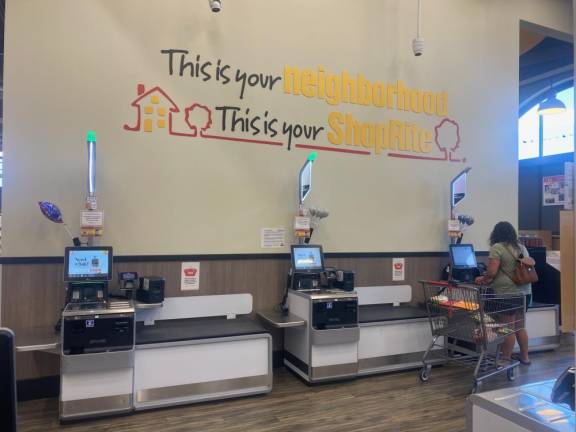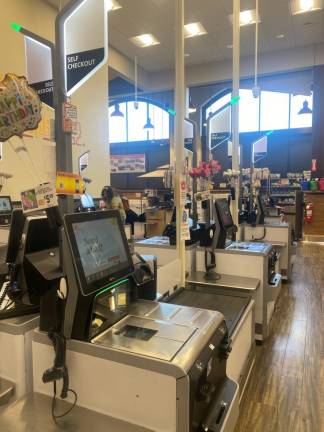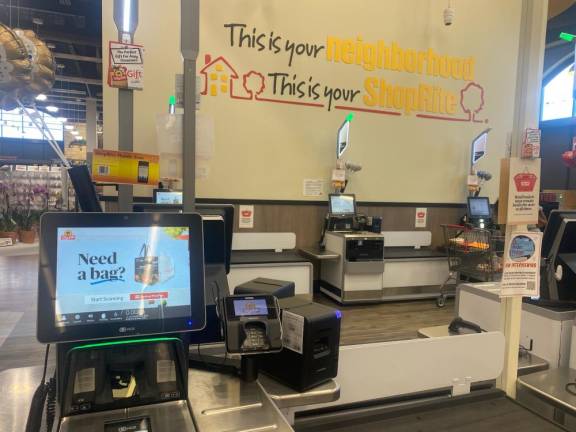Shoplifting in the era of heavy surveillance
Even with cameras on them, sticky-fingered shoppers are finding all sorts of ways to cheat the system.



Sometimes it’s a frazzled mom with kids in tow who’s fed up with a self-checkout machine that just won’t scan the sliced deli turkey. Occasionally, it’s a concerted effort by a ring of petty thieves planning to re-sell thousands of dollars’ worth of beauty products or baby formula online. People have unusually sticky fingers these days, despite the ubiquitous cameras capturing their every move.
Retailers nationwide have seen elevated levels of loss due to shoplifting, or “shrink” since the onset of the pandemic. “And it has been growing,” said Cathie Miller, consumer affairs coordinator for Ronetco Supermarkets, which operates eight ShopRites in New Jersey’s Sussex, Warren and Morris counties. That’s not a huge surprise. Historically, when times are tough shoplifting goes up. “Life’s stress often reflects in customer behavior in the stores,” said Miller. “The current challenge of inflation and rising prices has put stress on our customers and our stores alike.”
The kicker is that the technology that was supposed to prevent this kind of petty theft has in fact made the situation worse. Originally sold as foolproof and theft-proof, automated self-checkout systems were going to eliminate not only tedious lines and worker shortages, but also remove those notoriously unreliable humans from the equation. No more mis-counted change or employees giving “sweetheart deals” to friends and family.
Two decades in, it turns out that product disappears exponentially faster through the self-checkout kiosks. Walkouts, skip scanning, price tag switching and simple human error: it’s all happening right in front of the high definition cameras capturing shoppers’ every move.
Nine times out of ten, when shoplifting occurs these days, it’s through the self-checkout kiosks, said Kristin, who works in asset protection at a regional grocery store chain. She spoke on condition of using her first name because she did not have permission from her employer to discuss her job publicly. “We can tell when somebody’s being — for lack of a better term — stupid at the self-checkout as opposed to intentionally shoplifting,” said Kristin, an asset protection specialist. “I can’t prosecute them for being frustrated. I do understand the self-checkouts can be frustrating. They’re still slow.”
Widespread shoplifting has forced grocery stores — which operate on razor-thin margins, sometimes of less than one percent — to pass the cost of shrink along to the consumer. A typical American family spent an additional $435 on groceries in 2020 due to increased shoplifting, according to ITRetail, which sells point-of-sale systems including anti-theft software.
Why are self-checkouts a soft target?
Stealing from a self-checkout kiosk is “definitely easier,” said Christopher Andrews, a sociology professor at Drew University and author of The Overworked Consumer: Self-Checkouts, Supermarkets, and the Do-It-Yourself Economy. “It’s harder when you have one person watching like six self-checkout lanes to deter shoplifting than it is if you just have one person at a time going through a very narrow area.”
There is no substitute, it turns out, for a pair of human eyes. The eight Ronetco ShopRites in New Jersey installed their self-checkouts over a decade ago, an average of 16 kiosks per store. Like stores across the globe, they have noticed a disproportionate amount of product disappear through them. They believe they’re getting hit by a combination, said Miller, of individual shoplifters and organized rings that come in from out of the area or state.
A basic amenity?
Like it or not, the industry now views self-checkout as a necessity, since some customers, particularly younger or immune-compromised ones, tend to prefer it and might head to their competitor if they don’t offer the option.
“We had to, because all the other stores had them. Some customers were complaining,” said “Carol,” a longtime cashier at an Orange County ShopRite, which finally installed a dozen self-checkout kiosks about two years ago. “Carol,” a fake name, spoke on the condition of anonymity. “You know, we all dreaded it. I know one person retired because she didn’t think she could handle it. In an era of staffing shortages, they need the self-checkouts just to keep their doors open,” said Carol. “To get someone hired and get them to stay to midnight is very difficult. Nobody wants to commit to that.... These machines won’t ask for a day off. They don’t call out. As long as we keep them running, they’re dependable. We’re not.”
Self-checkout is the way of the future, and it’s risky to be the odd man out. “So now stores all have all these things, not necessarily because they want to but because they fear they’re going to lose part of the market segment if they don’t,” said Andrews, the sociology professor. With escalating surveillance to catch more cheating customers, the routine act of going shopping has taken on a “quasi-prison” dynamic, he said.
Hard-hit stores have little choice but to shell out more money to beef up surveillance. “It’s definitely expanded, they’ve put a lot more securities on it and everything,” said Kristin, of the self-checkout area at her store. “There’s a lot more cameras, definitely now, and they’re high def cameras. Like, we can see pretty much exactly what grocery you have in your hand at the time you’re purchasing.”
But some stores are holding out. “I don’t believe in it,” said Junior Dabashi, owner of Key Food in Milford, Pennsylvania. “The more you use self-checkout, you’re losing jobs for people. This is a small town — I like having people, not machines.” His family also owns Key Food stores in Beacon and New York City, none of which have self-checkout, though other Key Food stores do. “Our family is all in-person checkout,” he said.
Who knows whether that’s why his store isn’t seeing much theft. “Last maybe two years I thought it was going to be a mess, like they’re having in the city and all over the country. We probably caught maybe two people, like stealing something stupid: gum or one guy stole a cheese, you know? But nothing like major shoplifting, no.”
Dabashi understands the appeal of automation, especially during a labor shortage. “More of these bigger companies, especially, are going toward the self-checkout. It’s easier for them, they don’t have to worry about... whether [employees are] going to show up or not show up. It’s tough when you have employees and they decide, they don’t show up. You have to make sure you find a replacement. I think they’re going towards self-checkout. But for me personally, I don’t think I’ll ever go to self-checkout.”
Dealing with a human versus a robot fundamentally changes the shopping experience, he said. “It’s different. You want to make sure that somebody’s greeting you, you want to make sure somebody’s talking to you, want to make sure you feel welcome,” said Dabashi. “This is a family business. You want to make sure the customers do feel like they want to come back again.”
Organized rings
It’s not just grocery stores that find themselves in a surveillance arms race against a rising tide of shoplifters. At Woodbury Common and area malls, organized rings, usually of three to five people, have been working together to execute heists, hitting multiple stores back to back. It’s not a new phenomenon, but it’s been happening more since COVID, said Orange County District Attorney David Hoovler.
“Shoplifting in Orange County is up just slightly, but we have seen significantly more organized shoplifting in groups,” said Hoovler. One person distracts the employees, one scouts the exterior, one commits the theft, one’s driving, “and before you know it, they’re out the door,” he said.
“We’re catching a lot of them because there’s so much video. Everything’s on video, but you have to know what to look for and you have to be prepared for it,” he said. “When you go back and look at the video you can see what’s happening. Particularly, video of parking lots have become exceptionally compelling evidence. That’s where you see them all get out of the car and you see them all get in the car.”
Police departments are well aware of it, but much of the onus is on stores themselves to be their own first line of defense. “I think there’s a greater emphasis on video surveillance and training store staff better to recognize it,” said Hoovler. “The other problem is a lot of the loss prevention, they don’t want their staff to do anything. They see it happen, but they’re told just to let it go, and then report if after it happens, do nothing while it’s happening,” he said. “And then we’re stuck going back over the video, trying to get a license plate.”
For their part, stores are in somewhat of a precarious position regarding what the law allows them to do — not to mention what a store clerk is willing to do. “I’m not a legal expert, but my review of existing laws in the U.S. suggests that stores can attempt to detain suspected shoplifters for a reasonable, brief period but do not have the authority to pursue suspects outside the store or to use force in stopping suspected shoplifters,” said Andrews.
Woodbury Common, particularly, has become its own mini surveillance state. “There’s a camera every two feet, so that’s a positive,” said Hoovler. “The ability to solve the cases really relies on how much video evidence there is. There’s been a focus, particularly the parking lots and the walkways of ingress and egress leading to and from the stores.”
The spike in organized retail theft, which is making headlines in and near cities, hasn’t made its way to Pike County, Pennsylvania, said Pike County District Attorney Ray Tonkin. Unlike in Manhattan or Philadelphia, he said, “we have remained steady on prosecuting offenders of retail theft, and did not announce any policy that such offenders would not be prosecuted, which may in fact be the cause of the now increase in such crimes,” said Tonkin. His reference is to signaling by the district attorneys of Philadelphia and Manhattan since the pandemic that they would no longer lock people up for low-level crimes.
From makeup to food
Recently Kristin, whose job involves walking the floor as a “secret shopper,” has noticed a shift in what people are stealing. “There’s always going to be people who steal, like, makeup and hair stuff and vitamins and pregnancy tests and everything,” said Kristin. “But now, we keep an eye on everything. If somebody has a lot of food, we check to see.”
Once an offender has walked off with $100 worth of cumulative product, she turns over their file to the police. The company is simply looking to recoup the amount of the stolen goods, said Kristin, who previously worked as a grocery store manager. But because defendants often don’t show up to court, a shoplifting charge can snowball into an arrest warrant and a serious blemish on a person’s record.
In the past nine months, she’s dealt with just one organized retail theft case. In that case, totaling about $3,500 lost over 20 transactions, Kristin ended up stopping the suspect herself as the woman was walking out with $356 worth of stolen merchandise. It was her hairiest encounter to date, although the woman’s threats — asking what time Kristin got off work, where she lived — never came to anything.
“Most of my cases are people who just don’t want to pay for all of the extra food,” she said. “Food’s expensive right now.”


